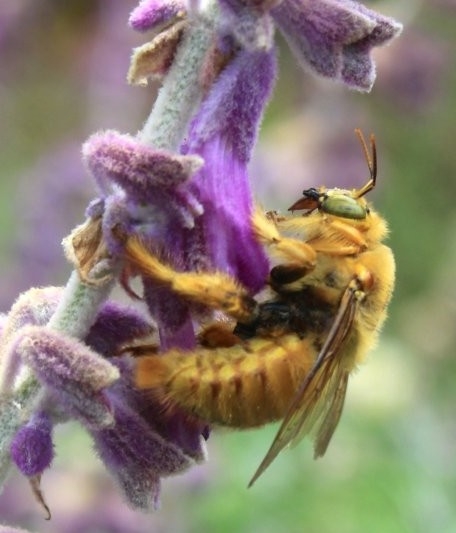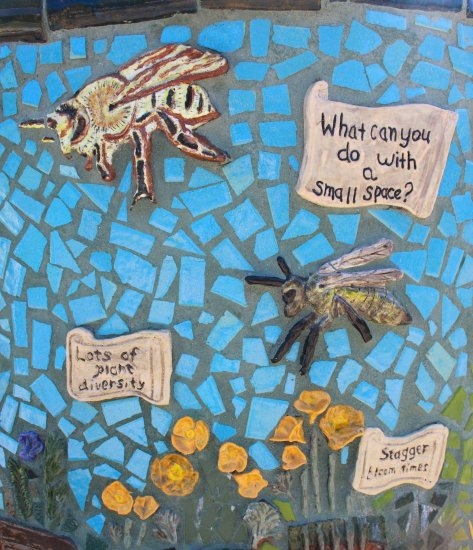The word “bee” usually brings to mind an image of a honeybee, but let's also remember the invaluable contributions and amazing diversity of our lesser-known native bee species.

In contrast, California has about 1,600 species of native bees! They are highly varied in size, ranging from 1/10 to 3/4 of an inch long. Many are scarcely recognizable as bees; some are fuzzy and grey, others are metallic green or blue, and some are even polka-dotted.
Some native bees are “social” and form colonies that nest in hives or large cavities. Bumblebees are the only social native bees in California, and they produce minimal honey since their hives last only a year. They are generalist feeders, foraging for nectar and pollen from different types of plants. They are also “buzz pollinators,” vibrating their wing muscles to dislodge pollen from flowers (a process essential to tomato and pepper plants).
The “solitary” native bees are much more plentiful than the social bees, and they generally congregate only to mate. They don't make honey and are much less likely to sting than social bees since they have no colonies to defend. Approximately 70% of solitary bees are ground-nesting, and they must tunnel into bare soil (not soil that is mulched or covered with plastic). The remaining 30% are cavity-nesting, which means they build their nests in tubular holes (hollow stems, burrows bored in wood, etc.). The females build the nests and often sleep in them, while the males shelter outside.
Solitary bees often have very evocative names: mason, leaf-cutting, miner, digger, sweat, cuckoo, carpenter, and more. Many are generalist feeders, but others (such as the sunflower and squash bees) are specialist feeders, which means they depend on a single type of plant as a food source.
Preservation of native bees is vital for both agriculture and a healthy ecosystem. Amazingly, research shows that some native bee species pollinate crops up to two times as effectively as non-native honeybees. Just as importantly, native bees evolved alongside our native wildflowers and other endemic plants and are best suited to be their pollinators.
Sadly, bee populations are declining, sometimes precipitously. While colony collapse disorder is causing sudden die-off in honeybee hives, native bee populations are also increasingly at risk due to habitat loss, pesticide use, invasive plants and insects, and introduced diseases. One unfortunate example is the western bumblebee (Bombus occidentalis), a once common and important pollinator that has now nearly disappeared from California and other states.
We can help protect and sustain native bee populations by:
- Planting a variety of native and ornamental plants with varying bloom times.
- Providing nesting habitat by preserving some open soil and building bee houses.
- Maintaining buffers of high-quality habitat and native vegetation near farmland, and planting hedgerows with diverse plant species.
- Reducing or eliminating the use of broad spectrum and systemic insecticides, which can harm all types of bees.
To learn more, read “California Bees & Blooms,” an excellent book written by several University of California bee experts. For bee identification guides, pollinator plant lists, and other resources, visit the Xerces Society website (www.xerces.org/pollinators-california-region/). The UC Berkeley Urban Bee Lab website (www.helpabee.org/) has an excellent overview of our state's native bees, information on bee gardening, and instructions for building bee boxes. To see a wide variety of bees, visit the Häagen-Dazs Honey Bee Haven, a public garden near the U.C. Davis campus.
For gardening related questions, call the UC Master Gardener office at 209-953-6112, or use our website: http://sjmastergardeners.ucanr.edu/CONTACT_US/.